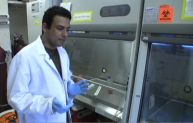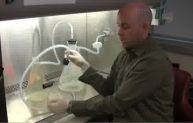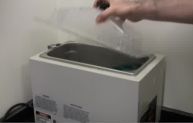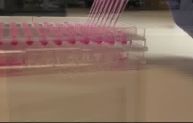110 Search Results for "cell culture and tissue culture"

Origin of life and living matter in hot mineral water, Prof. I. Ignatov, Dr. O. Mosin
https://benchfly.com/video/3445/origin-of-life-and-living-matter-in-hot-miner/Origin of life and living matter in hot mineral water, Prof. I. Ignatov, Dr. O. Mosin. Water for origination of life. “Water on Earth has contained more deuterium molecules according to Dr. Mosinâ€. Previous biological experiments with heavy water and structural-conformational studies with deuterated molecules, performed by us, enable to modeling conditions under which the first living forms of life might be evolved (Ignatov & Mosin, 2013a; Ignatov & Mosin, 2013b; Ignatov & Mosin, 2013c). The content of deuterium in hot mineral water may be increased due to the physical chemical processes of the deuterium accumulation. It can be presumed that primary water might contain more deuterium at early stages of evolution of first living structures, and deuterium was distributed non-uniformly in the hydrosphere and atmosphere (Ignatov & Mosin, 2012). The primary reductive atmosphere of the Earth consisted basically of gas mixture CO, H2, N2, NH3, CH4, lacked O2–O3 layer protecting the Earth surface from rigid short-wave solar radiation carrying huge energy capable to cause radiolysis and photolysis of water. The processes accompanying accumulation of deuterium in the hydrosphere are solar radiation, volcanic geothermal processes and electric discharges in the atmosphere. These natural processes could lead to the enrichment of the hydrosphere by deuterium in the form of HDO which evaporates more slowly than H2O, and condenses faster. If this is true, this is a significant fact regarding thermal stability of deuterated macromolecules in the preservation of life under thermal conditions, because chemical bonds with participation of deuterium are stronger than those ones formed of hydrogen. Natural prevalence of deuterium makes up approximately 0.015–0.020 at.%, and depends strongly on the uniformity of substance and the total amount of matter formed in the course of early Galaxy evolution (Linsky, 2007). Constant sources of deuterium are explosions of nova stars and thermonuclear processes frequently occurring inside the stars. Probably, it could explain a known fact, why the amount of deuterium is slightly increased during the global changes of climate in warming conditions. The gravitational field of the Earth is insufficiently strong for the retaining of lighter hydrogen, and our planet is gradually losing hydrogen as a result of its dissociation into interplanetary space. Hydrogen evaporates faster than heavy deuterium, which can be collected by the hydrosphere. Therefore, as a result of this natural process of fractionation of H/D isotopes throughout the process of Earth evolution there should be an accumulation of deuterium in the hydrosphere and surface waters, while in the atmosphere and in water vapour deuterium content tends to be low. Thus, on the planet there occurs a natural process of separation of H and D isotopes, playing an essential role in the maintenance of life on the planet. The second point regards the influence of temperature on the biochemical processes in living matter. Recent studies have shown that the most favorable for the origin of life and living matter seem to be hot alkaline mineral waters interacting with CaCO3 (Ignatov, 2010; Ignatov & Mosin, 2013d). According to the law for conservation of energy the process of self-organization of primary organic forms in water solutions may be supported by thermal energy of magma, volcanic activity and solar radiation. The accumulation of organic compounds in open lakes is more possible compared to the ocean. Life began near a hydrothermal vent: an underwater spout of hot water. Geothermal activity gives more opportunities for the origination of life. The origination of living matter most probably occurred in hot mineral water. This occurred in ponds and hydrothermal vents in seawater or hot mineral water. An indisputable proof of this is the presence of stromatolites fossils. They lived in warm and hot water in zones of volcanic activity, which could be heated by magma and seem to be more stable than other first sea organisms.

Growth Factor and Stem Cell Reagents
https://benchfly.com/video/814/growth-factor-and-stem-cell-reagents/Goldbio launches a new line of Growth Factors and Stem Cell Reagents This video provides information on growth factors, or, recombinant proteins, or, cytokines, also referred to as stem cell culture and neuronal culture. This is a new product offering from GoldBio. Announcing an exciting development at GoldBio. We have recently launched our newest product, a Recombinant Protein. Growth factors, or cytokines are a type of stem cell and neuronal culture used in many research applications as it relates to the very cellular building blocks. A downloadable PDF on the Growth Factor can be found here: http://bit.ly/VbqDSn To begin, we have over 35 widely used growth factors available, most notably FGF2 or basic FGF. It is complimented by many other human, rat, and murine growth factors such as BMP, CSF, EGF, EPO, FGF, GDNF, IGF, Noggin, NTF, SHH, VEGF.

How to Gas Parasites in Culture
https://benchfly.com/video/124/how-to-gas-parasites-in-culture/When working with plasmodium falciparum in culture, it's important to return them to a low oxygen environment before placing them back in the incubator.

Calculating How to Split Cells
https://benchfly.com/video/53/calculating-how-to-split-cells/Learning to accurately split cells among flasks of different sizes is critically important for keeping your cells in their optimal density range. However, planning the split is often way harder than actually performing the split. Keep it simple by focusing on this one factor.

Creating an Aspiration Apparatus
https://benchfly.com/video/28/creating-an-aspiration-apparatus/Creating an aspiration apparatus in the hood that has a safety trap and is easy to empty is an important part of good sterile technique. Without the proper equipment, you may end up with a house vac full of liquid and bacteria. So take the time to set up your apparatus right and prevent the hazmat team from shutting you down...

How to Keep a Clean Waterbath
https://benchfly.com/video/58/how-to-keep-a-clean-waterbath/Keeping a clean waterbath is an important step in preventing bacterial and fungal contaminations, which can wreak havoc on tissue culture rooms and incubators. This reagent will help keep your waterbath from becoming a slime bath.

ROKEPIE ® - How to store or transport cells and tissue at 2-8 degrees C
https://benchfly.com/video/2634/rokepie-how-to-store-or-transport-cells-and-t/Learn more about hypothermic preservation. This video shows you how to preserve cells & tissue at 2-8 degrees C. in the fridge. Ideal when you need to "pause" cells during the weekend, transport research material to another facility or want to extend shelf-life of your cells. ROKEPIE®is a new and innovative preservation product for all short-term preservation demands. It is non-toxic and very user-friendly. Just add, incubate, store, rewarm and re-use!

Working with Sterile Technique
https://benchfly.com/video/33/working-with-sterile-technique/Good sterile technique will save you countless hours of cleaning incubators, repeating experiments, and running from labmates. Here are the basics that will help you stay contamination-free.

Perfecta3D Hanging Drop Plates for 3D Spheroid Culture - Pipetting Demo
https://benchfly.com/video/1262/perfecta3d-hanging-drop-plates-for-3d-spheroi/Perfecta3D Hanging Drop Plates allow researchers to form uniform 3D spheroids or embryoid bodies. In a 96- or 384- well format, users simply pipet their cell suspension into each well, and it hangs in a drop below the well. As cells are in suspension, not in contact with any matrices or surfaces, they self-assemble into a spheroid. One spheroid per well gives researchers control over their data points and the size of each spheroid.

Top 5 Reasons to Use a Hypothermic Preservation Additive
https://benchfly.com/video/2751/top-5-reasons-to-use-a-hypothermic-preservati/Short video about the top 5 reasons why our market likes to use a hypothermic preservation additive like ROKEPIE. Showing application and benefits.

